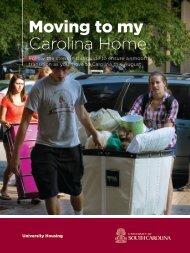Your Guide to Columbia, the University of South Carolina, and ...
Your Guide to Columbia, the University of South Carolina, and ...
Your Guide to Columbia, the University of South Carolina, and ...
Create successful ePaper yourself
Turn your PDF publications into a flip-book with our unique Google optimized e-Paper software.
A Brief<br />
His<strong>to</strong>ry <strong>of</strong><br />
<strong>South</strong><br />
<strong>Carolina</strong>’s<br />
Flagship<br />
<strong>University</strong><br />
The Palmet<strong>to</strong> State established <strong>South</strong> <strong>Carolina</strong> College—<strong>the</strong> precursor <strong>to</strong> <strong>the</strong> <strong>University</strong><br />
<strong>of</strong> <strong>South</strong> <strong>Carolina</strong>—on Dec. 19, 1801, as part <strong>of</strong> an effort <strong>to</strong> unite <strong>South</strong> Carolinians in<br />
<strong>the</strong> wake <strong>of</strong> <strong>the</strong> American Revolution. <strong>South</strong> <strong>Carolina</strong>'s leaders saw <strong>the</strong> new college as<br />
a way <strong>to</strong> promote "<strong>the</strong> good order <strong>and</strong> harmony" <strong>of</strong> <strong>the</strong> state. The founding <strong>of</strong> <strong>South</strong><br />
<strong>Carolina</strong> College was also a part <strong>of</strong> <strong>the</strong> Sou<strong>the</strong>rn public college movement spurred<br />
by Thomas Jefferson. Within 20 years <strong>of</strong> one ano<strong>the</strong>r, Georgia, North <strong>Carolina</strong>, <strong>South</strong><br />
<strong>Carolina</strong>, <strong>and</strong> Virginia established state-supported colleges. In <strong>the</strong> antebellum era, <strong>the</strong><br />
Palmet<strong>to</strong> State generously supported <strong>South</strong> <strong>Carolina</strong> College, <strong>and</strong> it became one <strong>of</strong> <strong>the</strong><br />
most influential colleges in <strong>the</strong> <strong>South</strong> before 1861, earning a reputation as <strong>the</strong> training<br />
ground for <strong>South</strong> <strong>Carolina</strong>'s<br />
antebellum elite.<br />
Rutledge DeSaussure McKissick Maxcy<br />
The Horseshoe campus<br />
The campus grew around <strong>the</strong> modified quadrangle <strong>of</strong> <strong>the</strong> Horseshoe. In 1805,<br />
four years after <strong>the</strong> college was chartered, its first building, Rutledge, was<br />
completed. Classes began that year with two faculty members <strong>and</strong> nine students.<br />
As <strong>the</strong> only academic facility, Rutledge served as classroom, lab, library, chapel,<br />
<strong>and</strong> student <strong>and</strong> faculty housing until DeSaussure was completed on <strong>the</strong> north<br />
side <strong>of</strong> <strong>the</strong> Horseshoe in 1809. Throughout <strong>the</strong> next 38 years, <strong>the</strong> Horseshoe <strong>to</strong>ok<br />
shape with eight more buildings. (The Horseshoe’s 11th building, <strong>and</strong> <strong>the</strong> only<br />
one not built in <strong>the</strong> 19th century, is McKissick, completed in 1940.) Robert Mills,<br />
<strong>the</strong> nation’s first federal architect <strong>and</strong> <strong>the</strong> designer <strong>of</strong> <strong>the</strong> Washing<strong>to</strong>n Monument,<br />
greatly influenced <strong>the</strong> architecture <strong>of</strong> <strong>South</strong> <strong>Carolina</strong> College. Mills was involved<br />
in <strong>the</strong> design <strong>of</strong> Rutledge, <strong>South</strong> Caroliniana Library, <strong>and</strong> Maxcy Monument in <strong>the</strong><br />
center <strong>of</strong> <strong>the</strong> Horseshoe, named for <strong>the</strong> first president <strong>of</strong> <strong>the</strong> college, Jonathan<br />
Maxcy. The <strong>South</strong> Caroliniana Library was <strong>the</strong> first freest<strong>and</strong>ing college library<br />
building in <strong>the</strong> nation when it was completed in 1840.<br />
Stability, post-war boom<br />
<strong>Carolina</strong> went through several reorganizations in which <strong>the</strong> curriculum frequently<br />
changed <strong>and</strong> its status shifted from college <strong>to</strong> university <strong>and</strong> back again. In<br />
1906, <strong>the</strong> institution was rechartered for <strong>the</strong> final time as <strong>the</strong> <strong>University</strong> <strong>of</strong> <strong>South</strong><br />
<strong>Carolina</strong>. In <strong>the</strong> early decades <strong>of</strong> <strong>the</strong> 20th century, <strong>Carolina</strong> made strides<br />
<strong>to</strong>ward becoming a comprehensive university, <strong>and</strong> in 1917 became <strong>the</strong> first s<br />
tate-supported college or university in <strong>South</strong> <strong>Carolina</strong> <strong>to</strong> earn regional<br />
accreditation. The 1920s witnessed fur<strong>the</strong>r progress <strong>and</strong> growth, with <strong>the</strong><br />
introduction <strong>of</strong> new colleges <strong>and</strong> degree programs, including <strong>the</strong> doc<strong>to</strong>rate. The<br />
Great Depression temporarily stalled this progress, but <strong>the</strong> outbreak <strong>of</strong> World<br />
War II launched an era that transformed <strong>the</strong> <strong>University</strong>. <strong>Carolina</strong> hosted Naval<br />
training programs during <strong>the</strong> war, <strong>and</strong> enrollment more than doubled in <strong>the</strong><br />
post-war era as veterans <strong>to</strong>ok advantage <strong>of</strong> <strong>the</strong> G.I. Bill.<br />
16



